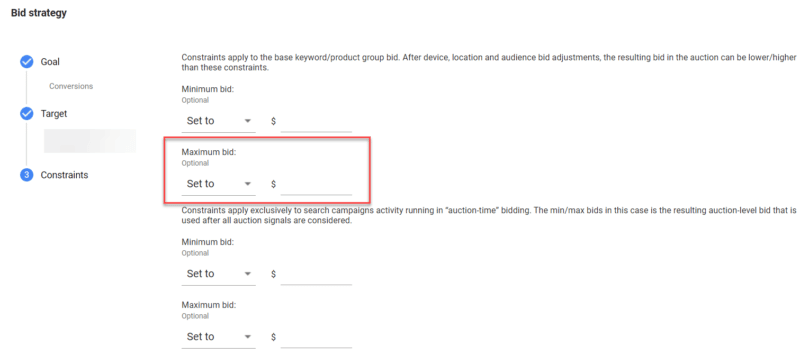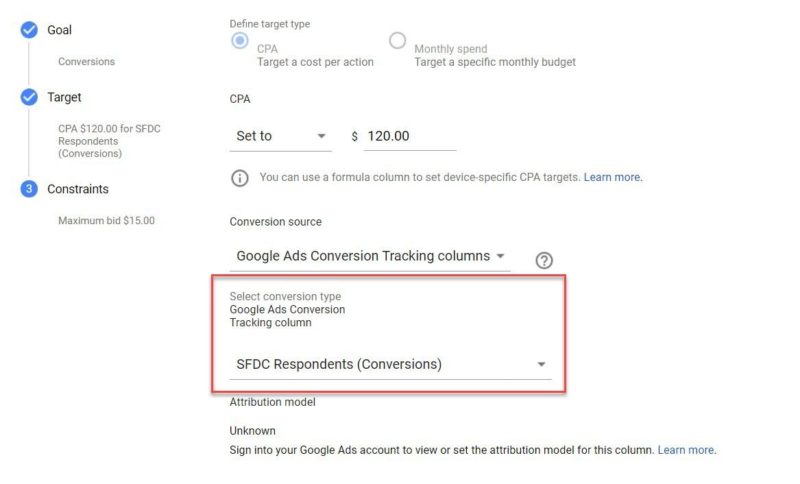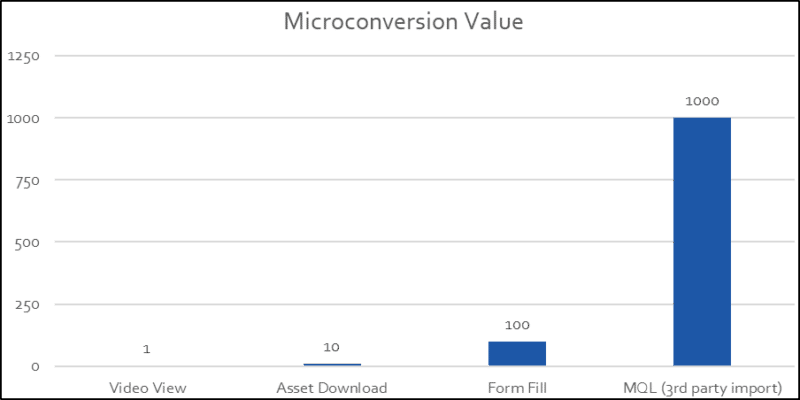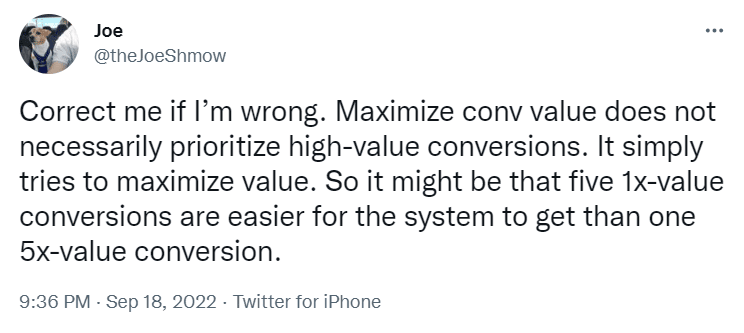At SMX Next in November, I was honored to give a talk on making automation work for lead generation when it’s not designed for lead generation.
A huge thank you to all who attended – the overtime Q&A was a lively session with many questions!
Lead generation automation challenges
Many of us are dealing with the challenges of lead generation in an advertising system that’s built for ecommerce. B2B lead generation is totally different from ecommerce, with fewer overall conversions, no shopping carts, no “conversion value,” and a long sales cycle that mostly takes place offline.
For automation to work optimally, the machine needs lots of data – a minimum of 20 conversions in a month. Many B2B campaigns struggle to reach that number of conversions, making automation challenging.
In addition, bid strategies like tROAS work based on the value of a conversion:
How do you value a B2B lead that won’t close for 18 months?
Some obvious automation options for lead generation
One option for lead generation advertisers is Target CPA (tCPA). Target CPA is a smart bidding strategy that sets bids for you to get as many conversions (customer actions) as possible.
If you don’t have a target CPA in mind, you can use Maximize conversions, which will attempt to get as many conversions as possible with your budget without regard to CPA.
At first glance, tCPA and Max conversions seem ideal candidates for automating lead generation. And they are, but they’re not perfect.
For one thing, both bid strategies can result in CPCs going through the roof as the automation system tries to find conversions at your target CPA, or just the conversions period.
Luckily, advertisers can control their CPCs – as long as they’re using a portfolio bid strategy.
If you are using portfolio bidding in Google Ads, you can set a max CPC for the portfolio. This option is also available in Search Ads 360 (SA360), if you use that:

The ability to set maximum bids is enough reason to use a portfolio bid strategy. It can save you from paying hundreds of dollars per click.
If you’re telling a machine to get you as many conversions as possible, you want to ensure you’re tracking conversions correctly!
I used an example of a client who was tracking page lands as a conversion:

While page lands might be a business goal, especially for advertisers looking for branding or awareness, it’s not a good goal for automation.
If you’re trying to maximize conversions and you’re measuring page lands, you’ll just drive more traffic to your site. There’s no guarantee that the traffic will actually result in more leads or revenue for your business.
Build your funnel
As mentioned earlier, getting enough leads to feed the automation algorithm can be a challenge for B2B lead generation.
I shared a few ways for advertisers to use mid-funnel tactics that can drive traffic to retarget to later on, and even possibly drive leads at a low cost.
One of those options is Discovery Campaigns.
Discovery campaigns can be an effective mid-funnel tactic for reaching audiences at scale. We’ve had success with Discovery ads for several of our B2B lead generation clients.
There were a lot of questions about Discovery during the session. Several questions focused on lead quality from Discovery campaigns.
We’ve found that the quality of leads our clients get from Discovery is similar to that of search campaigns.
Although Discovery ads reach users who are higher up the funnel compared to search, remember that the only bidding options for Discovery are Max conversions or tCPA. Therefore, lead quality is generally good.
We’ve also found that Discovery campaigns outperform Performance Max campaigns – to the point that we rarely use Performance Max due to low lead quality.
Getting quality leads
Speaking of lead quality, generating leads that actually convert to sales is one of the biggest challenges for lead generation advertisers.
Anyone can fill out a form online. Many of those who filled out a form will never become qualified leads.
And only a small percentage of those who become qualified leads will eventually turn into sales.
One way to help gauge the quality of your leads is to use imported third-party data.
Google first launched the capability to import Salesforce lead data back in 2016. Since then, they’ve added thousands of data connectors that advertisers can use to pull in data from their CRM system.
By importing data from the same system your clients are using to gauge lead quality, you can go beyond just form fills to see how many of those form fills turned into leads.
And if you get enough third-party leads, you can use them for Smart Bidding:

This screenshot is from SA360, but you can also use offline conversions for Google Ads bid strategies as long as you have them marked as Primary conversions.
You’ll need about 20 conversions per month for this to work, but if you have that many leads, it’s a great way to maximize actions that matter most to your clients.
Using a portfolio bid strategy is a good way to combine similar campaigns into a single bid strategy with enough conversion data to use third-party data for smart bidding.
Just make sure the campaigns have similar performance and objectives. Don’t combine brand and non-brand campaigns or campaigns with very different CPAs or goals.
And if you don’t get enough third-party conversions to use for smart bidding, at least use the data to gauge lead quality.
For example, we have a client whose primary goal is SQLs. However, they only get about 10 SQLs per month.
We optimize for MQLs, which are one level up the funnel from SQLs. We also import SQL data to see whether a campaign drives leads that matter to the client.
Some campaigns drive a lot of MQLs but no SQLs. We know to de-prioritize those campaigns in favor of others that drive more SQLs.
Using lead value with tROAS bid strategies
Lead generation advertisers often look at ecommerce advertisers with envy, because ecommerce advertisers can use the tROAS bid strategy, maximizing not only the number of sales they drive but the value of those sales as well.
One of the struggles with lead generation is the time it takes for a lead to become a sale. Sales cycles of 18 months to 2 years are not uncommon in B2B.
It’s challenging to determine the value of a lead before the lead goes through the whole buying cycle. This leads many B2B advertisers to write off tROAS as a strategy.
Not so fast!
Assigning a relative value to micro-conversions, such as white paper downloads or contact form fills, is an effective way to use the tROAS bid strategy.
Let’s say you have four actions you’re measuring: video views, asset downloads, form fills, and MQLs from a third-party import.
You can assign a relative value to each of these actions, like so:

In this example, an MQL is worth 1,000 times what a video is worth.
The tROAS strategy will look to maximize the value of conversions, not just the number. So it will prioritize MQLs and form fills over video views and asset downloads – thereby improving the quality of the leads it’s driving.
We got some good questions in the SMX session on this strategy.
One attendee asked how to avoid the “loop of doom,” where the system starts driving high volumes of low-value leads that never turn into MQLs. This can certainly be a problem:

The best way to avoid this is to assign low enough values to low-value actions and high enough values to high-value actions, so the system will work harder to drive the high-value actions. That’s why I set a value of 1,000 to MQLs in my example above.
Sometimes, even that’s not enough. Video views, for example, are so easy to generate that the system may well find it easier to drive thousands of video views than one MQL.
In this case, removing video views as a primary conversion is your best bet. Force the system to look for higher-value actions such as asset downloads and form fills instead.
On a related note, we got a great question about data-driven attribution:
“We have multiple primary conversion actions in our account based on different client goals (page views, form fills, calls, etc.). We’ve noticed the data-driven attribution model is impacting our lead gen actions because of the higher funnel actions. How would you recommend approaching data-driven attribution for lead gen, with multiple conversion actions in the account?”
If you find this is happening to you, I suggest changing some of your primary goals to secondary goals.
While this won’t keep data-driven attribution from looking at the secondary goals (since it looks at all interactions, including clicks, at least you’re telling the machine that these actions are not as important to you.
Using tROAS should also help tell the system which conversions are most meaningful to you in this case.
It’s all about signals
Remember, any automation is only as good as the signals it receives. It’s up to us as marketers to ensure we’re giving the best possible signals to the automation model so it can drive meaningful results for us.
Don’t forget about basics like audiences and negative keywords.
Advertisers often forget to add audiences for observation. Adding audiences is a great way to tell the system which users you’re interested in reaching – and in the case of negative audiences, which users you don’t want to reach.
Negative keywords are also important not only in preventing ads from showing on irrelevant queries but also in providing another signal to the machine.
Key takeaways
- Accurate tracking is key. Be sure you’re measuring actions that lead to business value and that you’re assigning an accurate value to each action.
- Build your funnel! Use Discovery and other higher funnel tactics like YouTube and Google Display to build audiences.
- Assess lead quality, not just quantity. Use the tactics in this article to guide you.
- Provide the right signals. Conversion value, along with audiences and negative keywords, all help the machine find high-value users.
- Know when to pull the plug! Automation doesn’t always work. We’ve had several instances where tCPA or max conversions yield fewer leads at a higher cost than manual CPC. It’s ok to turn off automation if it’s not driving the results you want!
Using the right tools, you can make automation work for lead generation, even if it’s not designed for lead generation.
Watch: Making automation work for lead gen
Below is the complete video of my SMX Next presentation.
Opinions expressed in this article are those of the guest author and not necessarily Search Engine Land. Staff authors are listed here.
New on Search Engine Land


